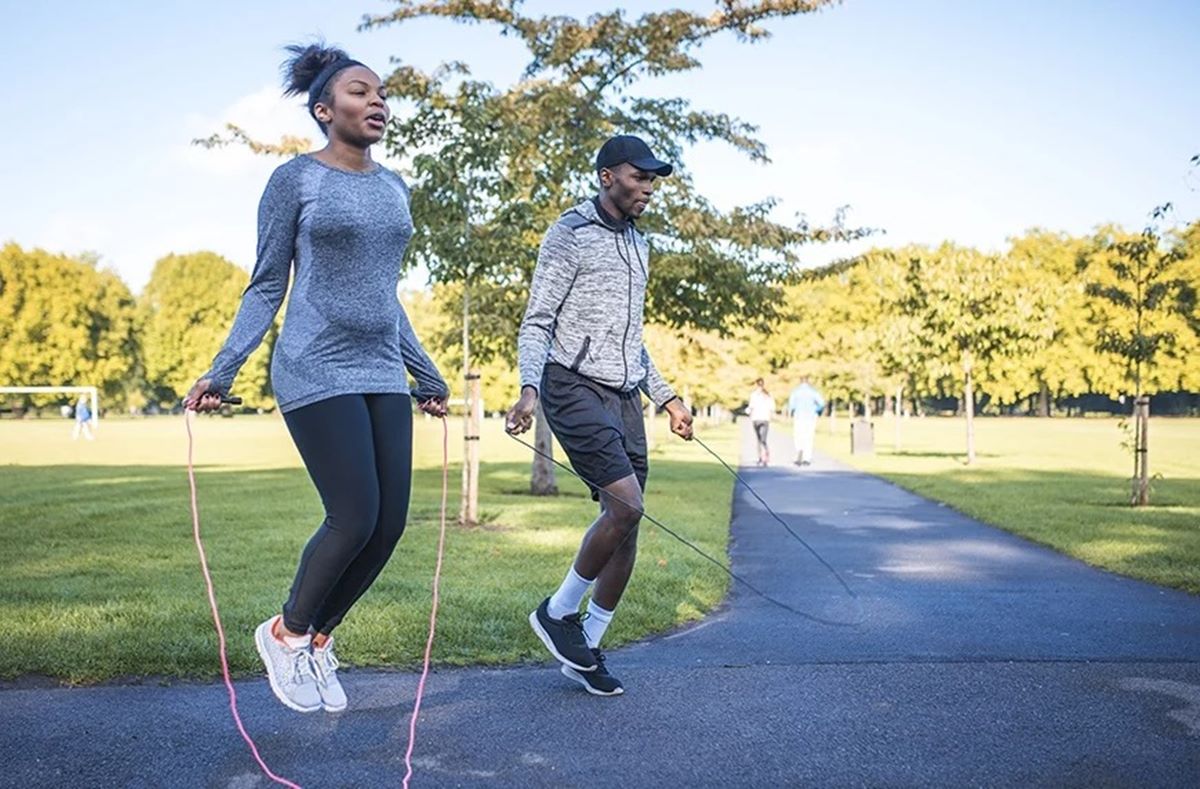

Featured
How To Increase Your Stamina Fast
Modified: January 22, 2024
Learn the featured techniques on how to increase your stamina fast and improve your endurance levels for a healthier and more active lifestyle.
Introduction
Stamina is an essential component of physical fitness that allows us to perform various activities for extended periods without feeling fatigued. Whether you’re an athlete training for a marathon or simply looking to improve your overall endurance, increasing your stamina can have numerous benefits.
With improved stamina, you can enhance your athletic performance, tackle daily tasks with ease, and even enjoy a higher quality of life. But what exactly is stamina, and why is it so crucial?
Stamina, also known as endurance, refers to the ability of your body to sustain physical and mental effort over an extended period. It directly impacts your energy levels, endurance, and overall efficiency in performing tasks. Stamina is not solely limited to physical endurance; it also encompasses mental stamina, which is the ability to concentrate and stay focused for prolonged periods.
Having good stamina is beneficial in various aspects of life. Whether it’s completing a challenging workout, participating in an outdoor adventure, or staying focused during a long workday, stamina plays a vital role in achieving success and maintaining a healthy lifestyle.
However, many factors can affect our stamina levels, including age, fitness level, lifestyle choices, and overall health. The good news is that there are effective strategies that can help you increase your stamina and reach your full potential.
In this article, we will explore the importance of stamina, discuss the factors that influence it, and provide valuable tips to help you increase your stamina quickly and effectively. By following these tips, you’ll be well on your way to boosting your endurance and achieving your fitness goals.
Understanding Stamina
Stamina is a vital aspect of physical fitness that refers to the ability of our body and mind to sustain prolonged physical and mental effort. It is closely linked to our cardiovascular and respiratory systems, as well as our overall energy levels.
Physical stamina is the ability to endure prolonged physical activities such as running, cycling, or engaging in sports. It involves the efficient functioning of our muscles, heart, and lungs. Mental stamina, on the other hand, relates to our ability to concentrate, stay focused, and endure mental tasks for extended periods.
Stamina is not something we are born with; it can be developed and improved through consistent effort and training. By challenging our bodies and gradually pushing our limits, we can gradually increase our stamina over time.
When we engage in endurance activities, our body adapts and becomes more efficient at delivering oxygen to our muscles and eliminating waste products. This process, known as aerobic adaptation, leads to improved stamina and endurance.
Stamina is measured by how long we can sustain an activity without feeling exhausted or experiencing a significant drop in performance. It is influenced by various factors, including genetics, age, fitness level, nutrition, and lifestyle choices.
Understanding our current stamina level is crucial in setting realistic goals and developing an effective training plan. By assessing our current endurance capacity, we can target specific areas for improvement and track our progress over time.
It’s important to note that developing stamina requires a holistic approach that involves proper nutrition, hydration, rest, and a well-structured training program. By addressing all aspects of our health, we can optimize our stamina and achieve optimal performance in various activities.
In the next sections, we will explore the importance of stamina, delve into the factors that affect it, and provide valuable tips on how to increase your stamina effectively. By incorporating these techniques into your routine, you can unlock your true endurance potential and accomplish your fitness goals.
Importance of Stamina
Stamina plays a pivotal role in our overall well-being and performance in various aspects of life. Whether you’re an athlete, a busy professional, or a stay-at-home parent, having good stamina can significantly enhance your physical and mental capabilities.
Here are some key reasons why stamina is important:
- Enhanced Physical Performance: Stamina is crucial for athletes and fitness enthusiasts as it directly impacts their ability to perform at their best. Whether it’s running a marathon, lifting weights, or participating in team sports, having good stamina allows individuals to endure longer, perform better, and achieve their desired goals.
- Improved Endurance: Daily tasks can often be physically demanding, and having sufficient stamina ensures that you can complete them efficiently without feeling excessively tired or fatigued. From household chores to outdoor activities, endurance is essential for maintaining a productive and active lifestyle.
- Increased Energy Levels: Good stamina provides a steady supply of energy, allowing you to stay energized throughout the day. This helps in combating fatigue and improves your overall productivity, focus, and mental clarity.
- Boosted Mental Resilience: Mental stamina is equally important as physical stamina. It enables you to stay focused, concentrate for longer periods, and tackle mentally challenging tasks without feeling mentally drained. This is especially beneficial in professional settings that demand high levels of mental concentration and endurance.
- Enhanced Cardiovascular Health: Building stamina through cardiovascular exercise improves the health and efficiency of your heart and lungs. Regular aerobic activity strengthens your heart muscles, lowers blood pressure, improves circulation, and reduces the risk of cardiovascular diseases.
- Stress Management: Physical exercise, which increases stamina, releases endorphins – the body’s natural “feel-good” hormones. This helps reduce stress levels, boost mood, and improve mental well-being.
Developing and maintaining good stamina is not only beneficial for physical and mental performance but also contributes to a higher quality of life. By having the endurance to engage in physical activities we enjoy, we can lead a more active and fulfilling lifestyle.
Now that we understand the importance of stamina, let’s explore the various factors that can affect our endurance levels and discover effective strategies to increase our stamina in the next sections.
Factors Affecting Stamina
Several factors can influence our stamina levels, both positively and negatively. Understanding these factors can help us identify areas for improvement and develop strategies to increase our endurance effectively.
Here are some key factors that can affect our stamina:
- Physical Fitness Level: Our overall physical fitness level has a significant impact on our stamina. Those who engage in regular exercise and have a higher level of cardiovascular fitness tend to have better endurance capacity compared to individuals who lead a sedentary lifestyle.
- Nutrition and Hydration: Proper nutrition and hydration are essential for maintaining optimal stamina. Nutrient deficiencies, inadequate calorie intake, and dehydration can negatively affect our energy levels and endurance performance. It’s important to fuel our body with a balanced diet and stay adequately hydrated to maximize our stamina.
- Rest and Recovery: Insufficient rest and recovery can lead to fatigue and reduce stamina. Continuous physical and mental stress without adequate rest periods can drain our energy and hinder our ability to perform at our best. Getting enough sleep and allowing for proper recovery between workouts is crucial for replenishing energy levels and enhancing stamina.
- Age and Genetics: Age and genetic factors can influence our stamina levels. As we age, our stamina naturally tends to decline due to physiological changes in our body. Additionally, some individuals may have inherited certain genetic factors that affect their endurance capacity.
- Mental resilience: Mental stamina is equally important as physical stamina. Factors such as stress, anxiety, and lack of focus can significantly impact our endurance. Building mental resilience through techniques like meditation and stress management can help improve our overall stamina.
- Training and Exercise Variety: Engaging in regular exercise and incorporating a variety of training methods can help improve stamina. By challenging our bodies with different types of workouts, such as cardiovascular exercises, high-intensity interval training (HIIT), and strength training, we can enhance our endurance capacity.
It’s important to assess and address these factors to optimize our stamina levels. By implementing strategies to improve in these areas, we can increase our endurance and perform better in various activities. In the following sections, we will provide valuable tips and techniques to help you boost your stamina effectively.
Tips for Increasing Stamina
Incorporating specific strategies into your routine can effectively help you increase your stamina. By following these tips, you can enhance your endurance and push your limits to reach new levels of performance. Here are some valuable tips for increasing stamina:
- Stay Consistent with Exercise: Consistency is key when it comes to improving stamina. Engage in regular physical activity and aim for at least 150 minutes of moderate-intensity aerobic exercise or 75 minutes of vigorous-intensity exercise each week.
- Incorporate Cardiovascular Exercises: Cardiovascular exercises such as running, cycling, swimming, or brisk walking are excellent for building stamina. Start with a comfortable pace and gradually increase the duration and intensity of your workouts.
- Implement Interval Training: Interval training involves alternating between high-intensity bursts of exercise and periods of active recovery. This method can improve cardiovascular fitness and help increase stamina more quickly. Try incorporating intervals into your cardio workouts by sprinting or increasing intensity for short intervals, followed by active recovery periods.
- Include Strength Training: Include strength training exercises in your routine to build muscle strength and endurance. Strong muscles support better physical performance and contribute to overall stamina. Focus on compound exercises that target multiple muscle groups, such as squats, lunges, push-ups, and deadlifts.
- Fuel Your Body Properly: Eat a balanced diet rich in carbohydrates, proteins, and healthy fats to provide adequate fuel for your workouts. Include whole grains, lean proteins, fruits, vegetables, and healthy fats in your meals to support optimal energy levels and endurance.
- Stay Hydrated: Proper hydration is crucial for maintaining stamina. Drink enough water throughout the day, especially before, during, and after your workouts, to prevent dehydration and support optimal performance.
- Get Sufficient Rest: Rest and recovery are essential for building stamina. Give your body enough time to rest and repair between workouts. Aim for 7-9 hours of quality sleep each night to promote proper recovery and maximize your endurance potential.
- Manage Stress Levels: Chronic stress can negatively impact your stamina. Incorporate stress management techniques such as meditation, deep breathing exercises, yoga, or engaging in hobbies to reduce stress levels and improve overall stamina.
- Gradually Increase Intensity: Gradually increase the intensity and duration of your workouts. Push your limits within a safe and manageable range to continuously challenge your body and improve stamina over time.
- Stay Motivated: Stay motivated and set realistic goals to improve stamina. Find activities you enjoy and incorporate them into your routine. Tracking your progress, celebrating milestones, and seeking support from others can help keep you motivated and committed to increasing your endurance.
By implementing these tips and techniques into your daily routine, you can effectively increase your stamina and achieve your fitness goals. Remember, patience and consistency are key when it comes to building endurance. Gradually progress, listen to your body, and stay committed to your fitness journey. The rewards of improved stamina and overall fitness levels will be well worth the effort!
Stay Consistent with Exercise
Consistency is key when it comes to increasing stamina and improving overall fitness. Regular exercise not only builds strength and endurance but also helps your body adapt to prolonged physical effort. Here are some tips to stay consistent with exercise and boost your stamina:
- Set Realistic Goals: Start by setting realistic goals that align with your current fitness level and schedule. It’s important to have clear objectives that you can work towards, whether it’s running a certain distance, completing a specific workout program, or participating in a sporting event.
- Plan Your Workouts: Plan your workouts in advance to ensure that they fit into your schedule. Treat exercise as a priority and allocate dedicated time for your workouts. This will help you stay accountable and avoid skipping sessions due to lack of time.
- Find Activities You Enjoy: Choose activities that you genuinely enjoy. Whether it’s running, cycling, dancing, swimming, or playing sports, engaging in activities that you find fun and enjoyable will make it easier to stay consistent with exercise. Trying out new activities can also add excitement and prevent boredom.
- Create a Workout Schedule: Establish a consistent workout schedule that incorporates a variety of exercises and allows for proper rest and recovery. Aim for a combination of cardiovascular exercises, strength training, and flexibility workouts. Gradually increase the intensity and duration of your workouts to challenge your body and improve stamina over time.
- Find an Accountability Partner: Partnering up with a friend, joining a fitness class, or hiring a personal trainer can provide the accountability and motivation you need to stay consistent. Having someone to exercise with or reporting your progress to can help you stay on track and push through any challenges.
- Track Your Progress: Keep track of your workouts and monitor your progress. Use a fitness app, a journal, or an online platform to record your exercises, distances, times, and other relevant data. Seeing your progress over time can be motivating and help you stay consistent in your training.
- Embrace Active Lifestyle Habits: In addition to planned workouts, incorporate physical activity into your daily routine. Walk or bike instead of driving short distances, take the stairs instead of the elevator, or engage in active hobbies such as gardening or dancing. These small lifestyle changes can contribute to your overall stamina and fitness levels.
Remember, consistency is key when it comes to increasing stamina. Find activities you enjoy and create a workout schedule that works for you. Stay committed, track your progress, and celebrate small victories along the way. With dedication and consistency, you’ll be able to build your stamina and achieve your fitness goals.
Incorporate Cardiovascular Exercises
Cardiovascular exercises are essential for improving stamina and enhancing your endurance levels. These exercises primarily focus on elevating your heart rate, increasing lung capacity, and improving the efficiency of your cardiovascular system. Here are some tips to help you incorporate cardiovascular exercises into your routine and boost your stamina:
- Select Suitable Activities: Choose cardiovascular exercises that you enjoy and that suit your fitness level. Running, cycling, swimming, rowing, dancing, and brisk walking are excellent options. Consider activities that can be easily incorporated into your lifestyle and can be sustained for longer durations.
- Start Slowly and Gradually Increase Intensity: If you’re new to cardiovascular exercises or have been inactive for a while, start slowly to avoid overexertion. Begin with low-impact activities and gradually increase the duration and intensity of your workouts over time. This allows your body to adapt and build endurance gradually.
- Warm Up and Cool Down: Before starting any cardiovascular exercise, make sure to warm up your muscles with dynamic stretches or light aerobic movements. After your workout, cool down with some gentle stretching to help your body recover and prevent muscle soreness.
- Interval Training: Incorporate interval training into your cardiovascular workouts. Alternate between high-intensity periods and recovery periods to challenge your cardiovascular system and improve your stamina more effectively. For example, sprint for 30 seconds, followed by a 1-minute recovery jog, and repeat the cycle several times.
- Progressive Overload: Gradually increase the duration and intensity of your cardiovascular exercises as your fitness level improves. This progressive overload principle helps to continually challenge your body and improve your endurance. Increase your workout duration by a few minutes each week or try increasing the intensity by incorporating hills or resistance.
- Mix Up Your Workouts: Avoid monotony by mixing up your cardiovascular workouts. Try different activities, routes, or equipment to keep things interesting. Cross-training with a variety of activities can not only boost your stamina but also work different muscle groups and prevent overuse injuries.
- Track and Monitor Progress: Keep a record of your cardiovascular workouts to track your progress. Note the duration, intensity, distances, or other relevant data to see improvements over time. This can be a great motivator and help you identify areas where you can push yourself further.
- Make It Fun: Make cardiovascular exercises enjoyable by adding music, podcasts, or audiobooks to your workout routine. Find a workout buddy or join a group exercise class to add a social element. When you find activities enjoyable, it becomes easier to stay consistent and motivated to improve your stamina.
Remember to listen to your body and adjust the intensity and duration of your cardiovascular exercises as needed. Stay committed and aim to engage in cardiovascular activities at least three to five times per week. By incorporating these tips into your routine, you can improve your cardiovascular fitness, increase your stamina, and enjoy the many benefits of enhanced endurance.
Implement Interval Training
Interval training is a highly effective method for improving stamina and boosting your cardiovascular fitness. It involves alternating between high-intensity bursts of exercise and periods of active recovery. This type of training challenges your body and pushes your limits, leading to increased endurance levels. Here are some tips to help you implement interval training and enhance your stamina:
- Choose a Suitable Exercise: Select an exercise that allows for variations in intensity, such as running, cycling, swimming, or using a cardio machine. Make sure you are comfortable with the chosen exercise and have the necessary equipment or space.
- Start with a Warm-Up: Begin your interval training session with a 5-10 minute warm-up of light aerobic activity and dynamic stretching. This prepares your body for the upcoming intense intervals and reduces the risk of injury.
- Set Work and Recovery Intervals: Determine the duration of your high-intensity work intervals and the duration of your recovery periods. A common approach is to start with a 1:1 work-to-recovery ratio, such as 30 seconds of intense exercise followed by 30 seconds of active recovery, and repeat for several cycles.
- Pace Yourself: During the work intervals, aim for a high intensity that challenges you but is sustainable for the duration of the interval. It should feel challenging but not so intense that you cannot complete the set or maintain proper form.
- Active Recovery: During the recovery periods, keep moving at a slower pace to allow your heart rate to decrease gradually. This helps your body recover and prepares you for the next intense interval. Examples of active recovery can be jogging, walking, or cycling at a moderate pace.
- Gradually Increase Intensity and Duration: As you become more accustomed to interval training, gradually increase the intensity and duration of your work intervals. You can decrease the ratio of recovery time to work time, or increase the intensity of your work intervals while maintaining the same recovery period.
- Experiment with Different Interval Formats: There are various interval formats you can try, such as Tabata intervals (20 seconds of intense exercise followed by 10 seconds of rest), ladder intervals (increasing or decreasing the duration of work intervals), or pyramid intervals (progressive increase, then decrease, in intensity or duration).
- Listen to Your Body: Pay attention to how your body feels during interval training. It’s normal to experience fatigue and elevated heart rate during the work intervals, but be sure to listen to your body’s signals and adjust the intensity or duration if you feel overly fatigued or experience any pain or discomfort.
- Recovery and Cool Down: After completing your interval training session, allow for a proper cool down period of 5-10 minutes of gentle aerobic activity followed by static stretching. This helps prevent post-workout muscle soreness and promotes proper recovery.
Interval training can be an effective way to improve stamina quickly. However, it is important to gradually progress and allow sufficient recovery between sessions. By implementing interval training into your workout routine, you can challenge your body, increase your endurance levels, and experience the benefits of improved stamina.
Include Strength Training
While cardiovascular exercises are important for improving stamina, incorporating strength training into your routine can also have a significant impact on your overall endurance levels. Strength training builds muscle strength and endurance, enhances overall body stability, and improves overall performance. Here are some tips to help you include strength training and boost your stamina:
- Focus on Compound Exercises: Incorporate compound exercises that target multiple muscle groups simultaneously. Examples include squats, lunges, deadlifts, push-ups, and rows. These exercises engage multiple muscles and promote overall strength and endurance.
- Start with a Warm-Up: Prior to strength training, warm up your muscles with some dynamic stretching or light aerobic exercises. This increases blood flow and prepares your body for the upcoming workout.
- Choose the Right Weight: Select a weight that allows you to perform 8-12 repetitions with good form and proper technique. The last few reps should challenge you, but you should still be able to maintain control over the movement.
- Incorporate Circuit Training: Circuit training involves performing a series of strength exercises in succession, with minimal rest between exercises. This keeps your heart rate elevated and provides a cardiovascular benefit alongside the strength training component.
- Gradually Increase Intensity: As you become stronger and more comfortable with your chosen exercises, gradually increase the weight or resistance to continue challenging your muscles. This progressive overload helps improve muscle endurance and strength over time.
- Include Plyometric Exercises: Plyometric exercises, such as squat jumps, box jumps, or burpees, involve explosive movements that increase power and overall muscle endurance. These exercises can be incorporated into your strength training routine or performed as a separate plyometric workout.
- Focus on Eccentric Movements: Eccentric movements, which involve contracting your muscles while they lengthen, are particularly effective for building endurance. Slowly lowering the weight or resisting the movement during the eccentric phase of an exercise can help improve muscular endurance and overall stamina.
- Take Rest Days: Allow for proper rest and recovery between strength training sessions. Muscles need time to repair and rebuild after intense exercise. Aim for at least one to two rest days per week to promote optimal recovery and prevent overtraining.
- Incorporate Core Exercises: A strong core is essential for overall body stability and proper posture during exercises. Include exercises that target your core muscles, such as planks, Russian twists, and mountain climbers, in your strength training routine.
Remember to maintain proper form and technique during strength training exercises to maximize the benefits and reduce the risk of injury. As you incorporate strength training into your routine, you’ll notice improvements in your muscle strength, endurance, and overall stamina. Combining strength training with cardiovascular exercises creates a well-rounded fitness routine and helps you become stronger, fitter, and more resilient.
Fuel Your Body Properly
Proper nutrition is crucial for increasing stamina and supporting optimal physical performance. The food you consume provides the energy and nutrients necessary to fuel your body during exercise and aid in recovery. Here are some tips to help you fuel your body properly and enhance your stamina:
- Eat a Balanced Diet: Focus on consuming a balanced diet that incorporates a variety of nutrient-dense foods. Include lean proteins, whole grains, fruits, vegetables, and healthy fats to provide the necessary macronutrients and micronutrients for optimal energy levels and performance.
- Carbohydrates for Energy: Carbohydrates are the primary source of energy for your body during exercise. Consume complex carbohydrates such as whole grains, legumes, and fruits, as they provide a sustained release of energy. Include them in your pre-workout meal or snack to fuel your workouts.
- Protein for Muscle Repair: Protein is essential for muscle repair and growth. Include lean sources of protein such as poultry, fish, eggs, beans, and tofu in your meals. Aim for an adequate protein intake to support muscle recovery and enhance endurance.
- Hydrate Properly: Proper hydration is essential for maintaining optimal stamina. Drink water throughout the day, especially before, during, and after exercise, to prevent dehydration. Consider sports drinks or electrolyte-rich beverages for intense or prolonged workouts to replenish lost electrolytes.
- Pre-Workout Nutrition: Before exercise, consume a balanced meal or snack that includes carbohydrates and protein. This provides the necessary fuel and nutrients for your workout. Experiment with different options to find what works best for you, such as a banana with nut butter, Greek yogurt with berries, or a small chicken and vegetable wrap.
- Post-Workout Nutrition: After exercise, consume a combination of carbohydrates and protein to aid in muscle recovery. This can be in the form of a balanced meal or a post-workout snack such as a protein shake, chocolate milk, or a veggie omelet with whole-grain toast.
- Timing of Meals: Pay attention to the timing of your meals. Aim to consume a meal or snack containing carbohydrates and protein 1-2 hours before your workout to allow for proper digestion and utilization of nutrients. Post-workout, refuel within 30-60 minutes to optimize recovery.
- Avoid Skipping Meals: Regularly fuel your body with balanced meals and snacks throughout the day. Skipping meals can lead to low energy levels and hinder your stamina. Aim for three main meals and 1-2 nutritious snacks to provide a steady source of energy.
- Listen to Your Body: Everyone’s nutritional needs are different, so it’s important to listen to your body and adjust your diet accordingly. Pay attention to how certain foods make you feel and experiment with different combinations to find what works best for your energy levels and performance.
Remember that proper nutrition is a vital component of enhancing stamina. By fueling your body with the right nutrients at the right time, you provide yourself with the necessary energy and support for optimal performance. Consult a registered dietitian if you have specific dietary questions or need personalized guidance to optimize your nutritional intake.
Stay Hydrated
Proper hydration is essential for maintaining optimal stamina and supporting overall physical performance. Water is involved in numerous bodily functions, including temperature regulation, joint lubrication, and nutrient transport. When we exercise, we lose water through sweat, so it’s crucial to replenish our fluids to stay hydrated. Here are some tips to help you stay hydrated and enhance your stamina:
- Drink Water Throughout the Day: Make it a habit to drink water regularly throughout the day, even when you’re not exercising. Aim for at least eight glasses of water per day, and increase your intake during hot and humid weather or intense workouts.
- Monitor Your Urine Color: Use the color of your urine as an indication of your hydration status. Ideally, your urine should be a pale yellow color. If it’s dark yellow or amber, it’s a sign that you need to drink more fluids to stay hydrated.
- Drink Before, During, and After Exercise: Prioritize hydration before, during, and after your workouts. Drink around 16-20 ounces of water two to three hours before exercise to ensure proper hydration. During exercise, sip water periodically to replace fluids lost through sweat. After exercise, replenish with fluids to restore hydration levels.
- Consider Electrolyte Drinks: For longer or more intense workouts, especially in hot environments, consider consuming sports drinks or electrolyte-rich beverages that can help replace electrolytes lost through sweat. These drinks can help enhance hydration and provide a source of carbohydrates for energy.
- Hydrate with Water-Rich Foods: In addition to drinking water, incorporate hydrating foods into your diet. Fruits and vegetables with high water content, such as watermelon, cucumbers, oranges, and berries, can contribute to your overall hydration levels.
- Listen to Your Thirst: Pay attention to your body’s thirst signals and drink water when you feel thirsty. Thirst is a natural indicator that your body needs hydration, so honor those cues and take sips of water to quench your thirst.
- Avoid Excessive Caffeine and Alcohol: Limit your intake of caffeinated beverages and alcohol as they can contribute to dehydration. These substances act as diuretics, increasing urine production and potentially leading to water loss. If consuming them, balance them with adequate water consumption.
- Monitor Hydration During Exercise: If you’re engaging in prolonged or intense exercise, pay attention to your hydration levels. Weigh yourself before and after exercise to see how much weight you’ve lost through sweat. For every pound lost, aim to consume around 16-24 ounces of fluid.
- Personalize Your Hydration Needs: Everyone’s hydration needs vary, depending on factors such as body weight, exercise intensity, duration, and environmental conditions. Tailor your hydration approach based on these factors and listen to your body’s signals to optimize your hydration levels.
Prioritizing proper hydration is essential for maintaining optimal stamina and overall health. By staying hydrated, you can enhance your endurance, maintain energy levels, and improve your performance during exercise. Make hydration a priority in your daily routine and adjust your fluid intake based on your individual needs and activity levels.
Get Sufficient Rest
Getting sufficient rest and allowing for proper recovery is essential for building stamina and optimizing performance. During periods of rest, your body repairs and replenishes itself, allowing you to bounce back stronger and more prepared for future challenges. Here are some tips to help you prioritize rest and enhance your stamina:
- Quality Sleep: Aim for 7-9 hours of quality sleep each night. Sleep is crucial for physical and mental recovery, as well as overall well-being. Create a bedtime routine, establish a comfortable sleep environment, and prioritize consistent sleep schedules to maximize the benefits of restful sleep.
- Plan Rest Days: Incorporate rest days into your weekly workout schedule. These days allow your body to recover and rebuild muscle tissues that have been stressed during exercise. Rest days can involve light activity or complete rest, depending on your body’s needs and preferences.
- Active Recovery: On rest days, consider incorporating active recovery activities such as light stretching, yoga, or gentle walks. These activities help improve blood flow, promote muscle recovery, and alleviate any soreness or stiffness from intense workouts.
- Listen to Your Body: Pay attention to any signs of overtraining or excessive fatigue. Pushing your limits during workouts is important, but it’s equally important to listen to your body’s cues for rest. If you are feeling excessively fatigued, experiencing persistent muscle soreness, or lacking motivation, consider taking additional rest days or reducing the intensity of your workouts.
- Manage Stress: Chronic stress can take a toll on your stamina. Implement stress management techniques such as meditation, deep breathing exercises, or engaging in hobbies that help calm your mind. By managing stress, you can minimize its adverse effects on both your physical and mental well-being.
- Stay Consistent with Bedtime Routine: Establishing a consistent bedtime routine and sleep schedule can help regulate your body’s internal clock. Going to bed and waking up at the same time each day helps optimize your sleep quality and ensures you get enough rest to support your stamina-building efforts.
- Allow for Proper Recovery: After intense workouts or challenging activities, allocate time for proper recovery. This includes consuming post-workout nutrition, stretching, foam rolling, or using other recovery tools to relax your muscles, and taking breaks when needed throughout the day.
- Focus on Relaxation: Incorporate relaxation techniques into your routine to promote restfulness. This can include activities such as taking warm baths, practicing mindfulness or deep breathing exercises, or engaging in hobbies that help you unwind.
- Regularly Assess Your Schedule: Evaluate your schedule for any potential stressors or overly demanding obligations. Prioritize activities that support your overall well-being, including rest and relaxation. Learning to balance your schedule can help you manage your energy levels and prevent burnout.
Remember that rest is just as important as exercise when it comes to building stamina. By prioritizing rest, you allow your body the opportunity to recover, rebuild, and adapt. Listen to your body’s cues, create a healthy sleep routine, and make time for regular rest and relaxation activities. By doing so, you’ll optimize your stamina and be better equipped to take on new challenges with improved performance and endurance.
Manage Stress Levels
Stress can have a detrimental effect on both physical and mental well-being, including stamina. Excessive stress can lead to fatigue, decreased motivation, and hindered performance. Managing stress is crucial for optimizing stamina and overall health. Here are some tips to help you effectively manage stress and enhance your stamina:
- Identify Stressors: Take time to identify the sources of stress in your life. It could be work-related deadlines, personal relationships, or other external factors. Understanding what triggers stress allows you to develop strategies to address and manage it.
- Practice Stress Reduction Techniques: Incorporate stress reduction techniques into your routine. This may include practices such as meditation, deep breathing exercises, yoga, or engaging in hobbies that help you relax and unwind. Experiment with different techniques to find what works best for you.
- Exercise Regularly: Regular physical activity has been shown to reduce stress levels. Engaging in cardiovascular exercises, strength training, or other forms of exercise helps release endorphins, improves mood, and reduces stress-related symptoms. Aim for at least 30 minutes of exercise most days of the week.
- Establish Boundaries: Learn to set boundaries in your personal and professional life. Prioritize self-care and make time for activities that recharge and energize you. Saying no to excessive demands can help prevent overwhelm and reduce stress levels.
- Practice Time Management: Poor time management can lead to increased stress. Develop effective time management skills by setting priorities, breaking tasks into manageable chunks, and creating a realistic schedule. This allows for better organization, reduces stress levels, and optimizes productivity.
- Connect with Others: Social support plays a vital role in managing stress. Maintain healthy relationships with friends, family, and loved ones. Sharing feelings and concerns with trusted individuals can help alleviate stress and provide perspective and support.
- Prioritize Self-Care: Engage in activities that promote self-care and well-being. This can include hobbies, spending time in nature, reading, taking baths, or practicing relaxation techniques. Making time for self-care enhances resilience to stress and improves overall stamina.
- Seek Professional Help: If stress becomes overwhelming or persists despite your efforts, don’t hesitate to seek professional help. A therapist or counselor can provide guidance and offer techniques to manage stress effectively.
- Practice Mindfulness: Cultivate mindfulness through practices such as mindfulness meditation or mindful awareness of the present moment. Mindfulness helps reduce stress by focusing on the present and accepting things as they are without judgment.
- Get Adequate Sleep: Sufficient sleep is essential for stress management. Aim for 7-9 hours of quality sleep each night to restore physical and mental well-being. Create a calming bedtime routine and ensure your sleep environment is conducive to relaxation.
Managing stress is a lifelong practice that requires awareness and consistent effort. By incorporating stress management techniques into your routine and prioritizing self-care, you can effectively reduce stress levels, enhance your stamina, and improve your overall well-being.
Gradually Increase Intensity
Gradually increasing the intensity of your workouts is a key strategy for building stamina and improving endurance. By progressively challenging your body, you allow it to adapt and become stronger over time. Here are some tips to help you gradually increase intensity and enhance your stamina:
- Start with a Solid Foundation: Begin with a comfortable level of intensity that matches your current fitness level. It’s important to establish a solid foundation before pushing yourself further to prevent injury and ensure long-term progress.
- Consistency is Key: Consistency is crucial when it comes to increasing intensity. Stick to a regular workout schedule and aim for regular exercise sessions throughout the week. This consistent effort will promote steady progress and prevent burnout.
- Progress at a Manageable Rate: Gradually increase the intensity of your workouts by small increments. Avoid significant jumps in intensity, as this can lead to overexertion and potential injuries. Slowly and steadily progress to allow your body to adapt and grow stronger.
- Focus on Quality over Quantity: Instead of solely increasing the duration of your workouts, emphasize the quality of your exercises. Ensure proper form and technique, and concentrate on exerting maximum effort during each repetition or interval.
- Implement Interval Training: Interval training, which involves alternating between high-intensity bursts and periods of recovery, is an effective method for gradually increasing intensity. Start with shorter and less intense intervals, and slowly increase the duration and intensity over time.
- Track Your Progress: Keep a record of your workouts and track your progress over time. This can be done through a fitness app, a journal, or an online platform. Tracking your progress helps you see your improvements and provides motivation to continue pushing yourself.
- Listen to Your Body: Pay attention to your body’s signals and adjust the intensity as needed. It’s normal to experience fatigue and muscle soreness, but it’s important to differentiate between normal discomfort and excessive strain. If you feel overly fatigued or experience pain, take a step back and modify your intensity accordingly.
- Incorporate Progressive Overload: Progressive overload is the principle of gradually increasing the demands placed on your body. You can achieve this by increasing the weight, repetitions, sets, or intensity of your exercises gradually over time. This stimulates your muscles and cardiovascular system to adapt and improve.
- Seek Professional Guidance: If you’re unsure about how to effectively increase intensity or progress in your workouts, consider seeking guidance from a qualified fitness professional. They can provide personalized recommendations tailored to your specific goals and fitness level.
- Patience is Key: Building stamina takes time and patience. Avoid rushing the process or trying to progress too quickly. Respect your body’s limits and allow it to adapt gradually. Trust in the process and celebrate the small wins along the way.
By gradually increasing the intensity of your workouts, you challenge your body and stimulate improvements in stamina and endurance. Remember to progress at a manageable rate, listen to your body, and prioritize consistency. With patience and dedication, you’ll see significant progress in your stamina and achieve your fitness goals.
Stay Motivated
Maintaining motivation is key to increasing stamina and achieving your fitness goals. As you work towards building endurance, it’s normal to face challenges and obstacles along the way. However, by staying motivated, you can overcome these hurdles and maintain the consistency needed to enhance your stamina. Here are some tips to help you stay motivated throughout your fitness journey:
- Set Realistic and Specific Goals: Define clear and attainable goals that align with your aspirations. Whether it’s completing a certain distance, improving your race time, or consistently exercising for a specific duration, establishing specific goals provides you with a clear target to work towards.
- Track Your Progress: Keep a record of your workouts, distances, times, or other relevant data. Tracking your progress not only allows you to see how far you’ve come but also serves as a visual reminder of your commitment and dedication. Celebrate milestones and use them as motivation to keep pushing forward.
- Vary Your Workouts: To prevent monotony and keep things interesting, incorporate variety into your workouts. Try new exercises, explore different training methods, or join group fitness classes to challenge yourself and maintain enthusiasm for your routine.
- Reward Yourself: Set up a reward system for reaching milestones or achieving specific goals. Treat yourself to something you enjoy, such as a new workout outfit, a massage, or a day off from training. These rewards can serve as powerful incentives to stay motivated and committed.
- Find an Accountability Partner: Partner up with a friend, family member, or workout buddy who shares similar goals. Having someone to exercise with or share your progress with can provide support, encouragement, and accountability. Share your challenges and celebrate each other’s successes.
- Visualize Success: Spend time visualizing yourself achieving your fitness goals. Imagine the feeling of crossing the finish line, completing a challenging workout, or surpassing your personal best. Visualizing success can help boost motivation and reinforce your belief in your ability to improve stamina.
- Engage in Goal-Related Activities: Surround yourself with activities that align with your fitness goals. Read books or articles on endurance training, join online communities or forums with like-minded individuals, or follow social media accounts that inspire and provide valuable insights and tips.
- Find Joy in the Journey: Shift your mindset to focus on the process rather than solely on the end result. Embrace the small victories, the steady progress, and the positive changes you experience along the way. Enjoy the journey of building stamina and remind yourself of why you started in the first place.
- Listen to Inspirational Content: Connect with podcasts, audiobooks, or motivational speeches that inspire and uplift you. Listening to others’ success stories, strategies, and words of encouragement can reignite your motivation and provide fresh perspectives.
- Be Kind to Yourself: Remember that building stamina takes time, and there will be ups and downs along the way. Be patient with yourself, celebrate your achievements, and show yourself self-compassion. Treat any setbacks as learning opportunities and use them to grow stronger and more determined.
Staying motivated is crucial for maintaining momentum on your journey to increase stamina. It’s normal to have moments of doubt or lack of inspiration, but by implementing these strategies, you can keep your motivation high and embrace the challenges that come with building endurance. Keep your eye on the prize and continue moving forward, knowing that each step you take brings you closer to achieving your goals.
Conclusion
Building stamina is a worthwhile endeavor that can enhance your physical and mental well-being, allowing you to perform activities with greater endurance and enjoy a higher quality of life. By understanding the concept of stamina, identifying its importance, and recognizing the factors that affect it, you can take meaningful steps towards improving your stamina levels.
Incorporating tips such as staying consistent with exercise, incorporating cardiovascular exercises, implementing interval training, including strength training, fueling your body properly, staying hydrated, getting sufficient rest, managing stress levels, gradually increasing intensity, and staying motivated will help you on your journey to increase stamina and improve endurance.
Remember, increasing stamina is a gradual process that requires patience, commitment, and consistency. Be sure to listen to your body, respect its limits, and adjust your routines and intensity levels accordingly. Celebrate both small and big milestones along the way, and enjoy the personal growth and the numerous benefits that come from increasing your stamina.
Embrace the journey and take pride in the progress you make. As you incorporate these strategies into your routine and continue to challenge yourself, you’ll discover newfound strength, resilience, and endurance that extend far beyond the physical realm.









